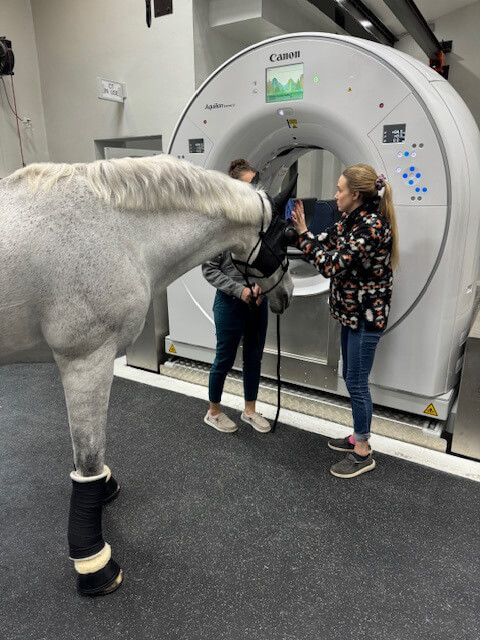When veterinarians work to diagnose illness or injury in a horse, they must rely on their knowledge, problem-solving skills, and the resources available to them. At Palm Beach Equine Clinic (PBEC), a new 2024 Canon Aquilion LB Exceed Dual Energy Computed Tomography (CT) scanner is making that process easier, faster, and more precise. Along with PBEC’s other imaging modalities, including radiographs, ultrasound, MRI, and nuclear scintigraphy, veterinarians can get a clear picture of what’s wrong, make a precise surgical plan if needed, and design comprehensive treatment plans. PBEC is the only facility in South Florida with a Canon Aquilion LB Exceed CT scanner, and it is available for referring veterinarians.
“It can be a life-saving technology,” said Dr. Karen Beste, a board-certified surgeon at PBEC and the head of the imaging team. “It can change outcomes for horses. In its first month of use, the new Canon CT scanner has already told us that a horse didn’t have the fractured leg that we initially thought. We were able to take the horse directly into surgery and save its life.”

The new CT scanner at PBEC is able to show detail that is not detectable on routine imaging modalities, providing soft tissue detail. In addition, it can help veterinarians scan areas of the equine body that were previously difficult or impossible to see, such as the pelvis, sacroiliac, hip joints, stifles, entire limbs, and the neck.
“The neck is a really difficult area to image,” said Dr. Beste. “Routine radiographs don’t provide 3D detail. We can add contrast for myelograms, which allows us to look for dynamic compressions in the spine. We can see detailed changes that may impact a horse’s ability to perform and be a safe horse to ride. We are able to get full neck CTs, all the way to thoracic vertebrae, even on really large horses. Because acquisition times of images are so fast, horses are under general anesthesia for a very short time, which is better for any horse but particularly for a neurologic horse.”

While PBEC’s Canon Aquilion LB Exceed CT scanner has incredible technology, it’s nothing without the experts to manage the scanning and read the scans, which include board-certified radiologists Dr. Sarah Puchalski and Dr. Stacie Aarsvold, who look at every scan.
“Images are viewed by world-renowned radiologists the moment we get them,” noted Dr. Beste. “The whole imaging team is well trained and has so much experience. In addition to that, some of the best surgeons in South Florida can be present during the scan. If needed, horses can be taken directly from the CT into surgery, where CT-guided surgeries are performed. It is especially helpful if a horse is already under general anesthesia because they can go right into surgery in one anesthetic episode. The CT can make a surgical approach more precise, and the surgeon is able to perform it more quickly. The surgeon knows exactly what they need to do and doesn’t have any guesswork.”
If you or your veterinarian would like to take the guesswork out of diagnosing your horse, reach out to the PBEC team today to learn more or make an appointment for a scan at 561-793-1599.